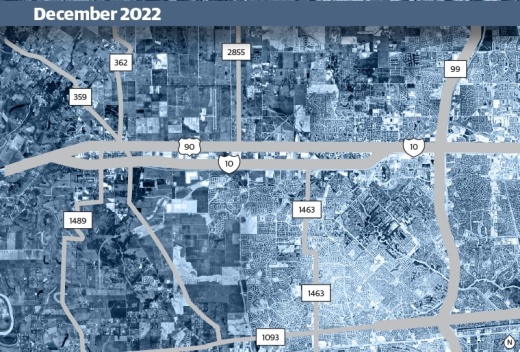The population of the Katy area in ZIP codes 77084, 77094, 77441, 77449, 77450 and 77493 skyrocketed by 92% between 2000-10, according to data from the Katy Area Economic Development Council. That number increased again from 355,261 in 2010 to 571,802 in 2022.
The Texas Demographic Center, the state-level liaison to the U.S Census Bureau, projects the population in those ZIP codes will reach 872,948 in 2033. The majority of growth has been concentrated in the western portion of Katy and along various corridors where major thoroughfares are present, said Chuck Martinez, the president of the Katy Area Economic Development Council.
“So much of the Katy area experiences very fast-paced growth,” Martinez said. “If you just look generically over the last 10 years of what was here and what was not here, that shows you the pace of that growth and the old adage of ‘build it and they will come.’”
The Katy Area EDC collects data to encourage economic development and attract companies, jobs and talent to the region. In 2023, Martinez said the EDC will hone in on its strategic plan, a forward look at Katy’s workforce landscape.
Meanwhile, new communities are being built in the Fulshear area to accommodate interest in the region, and the Texas Department of Transportation plans to invest millions to improve mobility in the area.
Preparing infrastructure
Most of the area’s growth is happening north of FM 1093 and along the Texas Heritage Parkway with multiple master-planned communities, such as Cross Creek Ranch, Tamarron and Cross Creek West, along the corridor, Fulshear Assistant City Manager Zach Goodlander said.
Goodlander said most of these are in the city of Fulshear’s extraterritorial jurisdiction, which typically limits the amount of influence city officials have over development.
However, the city and developers began entering into development agreements in 2006 that regulate lot size, density and land use as well as ensuring roads and utility infrastructure are being built to the city standard, Goodlander said.
“The development agreement is a useful tool for both parties,” Goodlander said. “There are less question marks from the developer side, but for the city side, it’s a good way of at least ensuring some additional regulation applies that we otherwise wouldn’t normally have.”
Developers in Fort Bend County are responsible for their own infrastructure from utilities to sanitation systems and the streets that connect to major roadways, said Mark Vogler, Fort Bend County Drainage District general manager and chief engineer.
“They create municipal utility districts, which then in turn supply their water, storm sewer system, detention ponds, sewer systems, and then they pay to that through a ... utility district tax,” Vogler said.
But the drainage district is conducting a master drainage plan to configure the cost of this practice and the balance of rainfall and water infiltration, which should be completed in late May, Vogler said.
The big political question, he said, is whether the county can afford to create regional detention channels or if the onus should remain on developers to offset their own drainage impacts.
“The county is looking at what it would cost to improve [our] 41 major streams to handle Atlas 14 rainfall that is 16.5 inches,” Vogler said. “We do not have a definite number yet, but insofar we are talking $3 [billion] to $5 billion to make those kinds of improvements.”
Refining thoroughfares
Building connectivity through roadways is one thing that will continue to draw new residents to the Katy community, Martinez said.
Along I-10, which runs east to west and crosses the Grand Parkway, TxDOT has slated at least six projects over the next 10 years to widen the thoroughfare from Hwy. 6 to FM 359 in Brookshire. Projects will add lanes and continue frontage roads to ease congestion, TxDOT Public Information Officer Emily Black said.
In the Katy area, these include four widening projects from Hwy. 59 to Mason Road, which are set to be completed by August 2030 and will cost $493.16 million.
Construction is slated to take place between June 2023 and December 2025 along the Grand Parkway to widen the thoroughfare from four to six lanes in both directions from FM 1093 to the Harris County line and add frontage roads along portions of it.
Black said bids for a portion of the Grand Parkway widening project went out to engineers Jan. 5 with construction planned to start around June.
Near Fulshear, FM 1093 will become a major thoroughfare connecting residents to the Energy Corridor, the Texas Medical Center and other areas in Houston, Goodlander said.
TxDOT plans to begin constructing a four-lane toll lane from 0.6 miles west of Spring Green Boulevard to FM 1463 along the roadway by 2026, per its project tracker tool. The agency also plans to widen FM 1093 sometime after 2033 from a two-lane undivided road to a four-lane divided road from FM 1489 to FM 359.
Finally, FM 1463, less than 2 miles from the Texas Heritage Parkway, will serve both the Katy and Fulshear communities as a north-south connector, Goodlander said.
TxDOT has two projects planned for completion by the end of July 2026 along this thoroughfare totaling $106.55 million. These will widen the roadway from two to four to six lanes, add sidewalks and add a raised median. Starting dates for the work along I-10, FM 1093 and FM 1463 were not provided by TxDOT.
Building the economy
Many of the Katy area’s leading employers have headquarters along these major thoroughfares, including the Westpark Tollway and the Grand Parkway—a trend that is common in areas that experience tremendous growth, Martinez said.
“Things that typically go hand in hand with population growth are restaurants, financial and health care [businesses],” Martinez said. “They tend to cluster around rooftops.”
Kyle Stanzel, chief operating officer for Houston Methodist West, said he anticipates the hospital will need to add at least 129 more beds for a total count of 400 by 2033. This hospital is undergoing several multimillion-dollar expansion projects, including the construction of a third medical office building concluding in 2023. The medical building will staff about 300 employees.
In 10 years, Stanzel said he expects to add 1,600 employees to the staff of about 2,000 to maintain facilities. The main challenge, he said, will be developing the talent of the future.
“It is critical that we continue to work with our education partners to educate students about opportunities in our industry so we can bring that top talent back to Katy and West Houston,” Stanzel said.
Another driver to the Katy area’s population growth has been Katy ISD, which Martinez said is expected to reach 100,000 students by 2027-28.
The Katy Area EDC listed KISD as the top 2022 employer in the area. According to the KISD Human Resources Department, the district has 12,565 total staff, not including substitute teachers and temporary workers.
In total, based on new schools and population growth, KISD human resources staff said the district could see up to 5,000 new positions created across all job levels by 2032.
Martinez said he thinks employer growth will coincide with the industries that are already targeted by the area’s EDC—which include the energy sector, life sciences, manufacturing, research and development industries, and regional headquarters companies.
In 2023, the EDC will continue developing its strategic plan, which aims to fortify the Katy area’s economic development. It will focus on marketing and business development, competitiveness and effective organization.
Martinez said the EDC’s collaboration with the Greater Houston Partnership, the Houston area’s largest chamber of commerce, will help attract companies and quality jobs.
“We are always going to be focusing on our relationships across the region, not only with institutions like ourselves, but also with members of our organization and [identifying] what their roles are,” he said.







